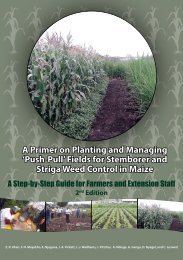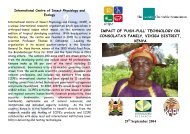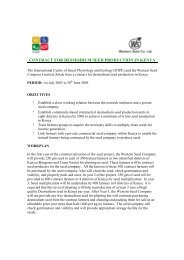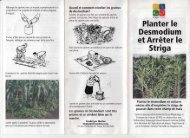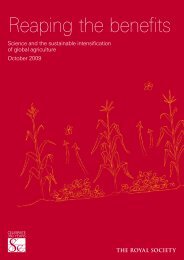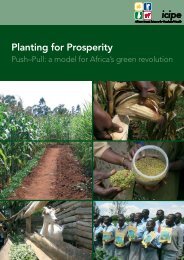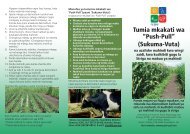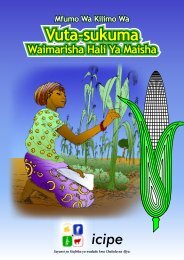Biology and management of economically important ... - Push-Pull
Biology and management of economically important ... - Push-Pull
Biology and management of economically important ... - Push-Pull
You also want an ePaper? Increase the reach of your titles
YUMPU automatically turns print PDFs into web optimized ePapers that Google loves.
702 KFIR ET AL.<br />
PEST STATUS AND YIELD LOSSES ....................................708<br />
MANAGEMENT ......................................................709<br />
Utilization <strong>of</strong> Synthetic Sex Pheromones .................................709<br />
Cultural Control .....................................................710<br />
Intercropping <strong>and</strong> Habitat Management ..................................711<br />
Management <strong>of</strong> Crop Residues .........................................712<br />
Manipulation <strong>of</strong> Sowing Dates <strong>and</strong> Densities ..............................714<br />
Fertilizer ...........................................................715<br />
Host Plant Resistance ................................................715<br />
Breeding for Resistance ...............................................716<br />
Biological Control ...................................................716<br />
INTRODUCTION<br />
Cereals, especially maize <strong>and</strong> sorghum, are the most <strong>important</strong> field crops grown in<br />
Africa by commercial <strong>and</strong> resource-poor small-scale farmers (94, 167). Sugarcane<br />
is also an <strong>important</strong> cash crop grown in some areas. The crops are grown primarily<br />
for human consumption, but surpluses are used for feeding livestock (176). Among<br />
the insect pests attacking these crops in Africa, the lepidopteran stem borers are by<br />
far the most injurious (224). Because <strong>of</strong> their economic importance, stem borers<br />
have been the subjects <strong>of</strong> many studies, which resulted in an enormous amount<br />
<strong>of</strong> literature. This review summarizes the status <strong>of</strong> knowledge about cereal stem<br />
borers in Africa.<br />
STEM BORERS AND THEIR DISTRIBUTION<br />
Maes (105) listed 21 <strong>economically</strong> <strong>important</strong> lepidopteran stem borers <strong>of</strong> cultivated<br />
grasses in Africa, including 7 noctuids, 2 pyralids, <strong>and</strong> 12 crambids. Of these<br />
21 species, 7 are primarily pests <strong>of</strong> rice, <strong>and</strong> one mainly attacks pearl millet in the<br />
Sahelian region. Among the noctuids, Busseola fusca <strong>and</strong> six Sesamia spp. are<br />
considered <strong>economically</strong> <strong>important</strong>. Two pyralids are serious pests: the rice borer,<br />
Maliarpha separatella, <strong>and</strong> Eldana saccharina, a pest <strong>of</strong> sugarcane <strong>and</strong> maize.<br />
The largest group (12 species) <strong>of</strong> injurious stem borers are crambids, with the majority<br />
(7 species) belonging to the genus Chilo Zincken. Within specific crops <strong>and</strong><br />
geographic regions, fewer species are considered to be <strong>important</strong> pests (Table 1).<br />
In South Africa, B. fusca <strong>and</strong> Chilo partellus are the only <strong>important</strong> stem<br />
borers <strong>of</strong> maize <strong>and</strong> sorghum (94), while in sugarcane in the same region, only<br />
E. saccharina is considered to be a serious pest (47). In East Africa, C. partellus,<br />
Chilo orichalcociliellus, E. saccharina, B. fusca, <strong>and</strong> Sesamia calamistis are mentioned<br />
as <strong>important</strong> <strong>and</strong> widely distributed stem borers <strong>of</strong> maize <strong>and</strong> sorghum<br />
(168). Major stem borers <strong>of</strong> maize <strong>and</strong> sorghum in West Africa include B. fusca,<br />
S. calamistis, <strong>and</strong> E. saccharina (34). In the Sahelian zone, where pearl millet is the<br />
most <strong>important</strong> cereal crop, Coniesta ignefusalis is the dominant stem borer (73).



